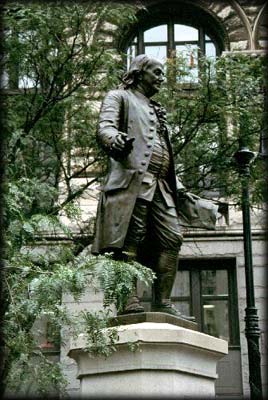Benjamin Franklin
Printing House Square
Located opposite City Hall Park, at the intersection of Park Row and the Brooklyn Bridge approach, this impressive sculpture of American statesman, scientist, inventor, philosopher, and journalist Benjamin Franklin (1706–1790) is by German-born sculptor Ernst Plassman (1823–1877). The sculpture was dedicated in 1872.
Franklin is one of the most extraordinary and influential figures in American history. Born in Boston, Massachusetts, he apprenticed to his brother James, a printer. After writing some satirical essays, he settled in Philadelphia in 1723 where he published the Pennsylvania Gazette (1730-48), and achieved widespread attention for his popular commentary in Poor Richard’s Almanack (1732-57). In 1727 he established a debating society known as Junto, which by the mid-1740s evolved into the American Philosophical Society. Also in the realm of intellectual pursuits, Franklin helped found the Academy of Philadelphia in 1751, which later became the University of Pennsylvania.
Possessing a nimble mind, Franklin left his mark on science and industry. His experiments with electricity include the oft-reported use of a kite as a conductor during a lightning storm. Some of his more practical inventions include an open stove for home heating (dubbed “the Franklin stove”), bi-focal eyeglasses, and the lightning rod.
Franklin was active extensively in matters of public affairs and government. He served as Deputy Postmaster General of the colonies from 1753 to 1774. At the Albany Congress of 1754, as a Pennsylvania delegate, Franklin was a forceful advocate for uniting the colonies. In 1775 he was an important member of the Second Continental Congress, served on the committee to draft the Declaration of Independence, and was a signer of this essential document in the establishment of the United States of America.
During the Revolutionary War Franklin was active in diplomatic affairs. He was one of three Colonial committee members who met at the Billop House (now the Conference House) on Staten Island’s south shore, and attempted, unsuccessfully, to arrive at a peaceful resolution to the mounting conflict with the British. In 1776 Franklin negotiated a treaty with France, and remained there as a diplomatic liaison until 1785, when he returned to Philadelphia. In his waning years Franklin served as president of the Pennsylvania executive council (1785-87) and was a member of the Constitutional Convention of 1787. He died on April 17, 1790 in Philadelphia.
This sculptural portrait of Franklin was commissioned as a gift to the City by Albert De Groot (1813–1884), a retired Hudson Valley steamboat captain. Park Row was for decades the center of New York’s publishing industry and newspaper businesses, and given Franklin’s activities as a printer of paper currency and publisher of newspapers and almanacs, the choice of location was particularly apt.
DeGroot had earlier collaborated with Plassman on the creation of the Cornelius Vanderbilt statue (1869), which stands in the viaduct in front of Grand Central Terminal. This colossal bronze effigy depicts Franklin in 18th-century dress, holding a copy of the Philadelphia Gazette. A second casting may be viewed in the lobby of the High School of Graphic Communication Arts at 439 West 49th Street. On January 17, 1872, the 166th anniversary of Franklin’s birth, the statue was formally unveiled in a lavish ceremony in which artist and inventor Samuel F. Morse (1791–1872) removed the shroud and newspaper publisher Horace Greeley (1811–1872) delivered the keynote address. Charles C. Savage, speaking on behalf of the New York Typographical Society, commented: “It is appropriate that this statue should be erected in this centre of our trade, in the very midst of our craft-work, instead of in Central Park; for Franklin’s life was devoted to practical hard work, rather than to the ornamental and the recreative.”
Today the sculpture stands in a small triangle, with Pace University as its backdrop. Having suffered from environmental corrosion, the statue was treated and restored by the Parks’ monuments crew on four occasions between the 1940s and the 1980s. In 1999 the City Parks Foundation Monuments Conservation Program, with funding from the Florence Gould Foundation, American Express Company, and Samuel H. Kress Foundation, conducted a complete conservation of the statue and its large granite pedestal. Today this portrait of an American icon, with renewed luster, maintains his watchful gaze over this crossroads of civic life.
Monday, Dec 17, 2001
